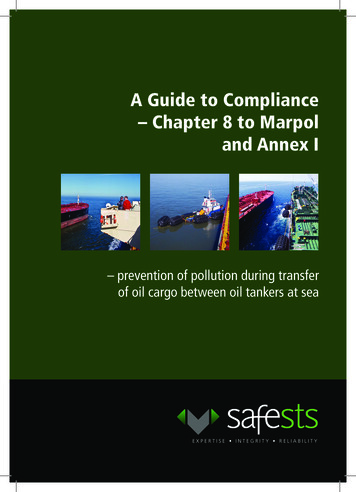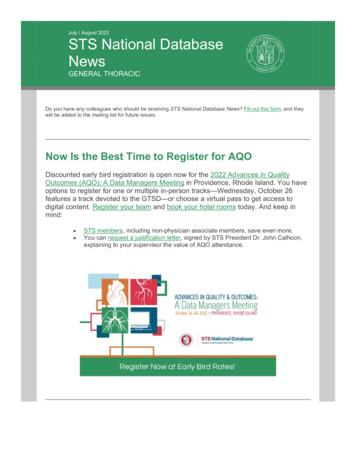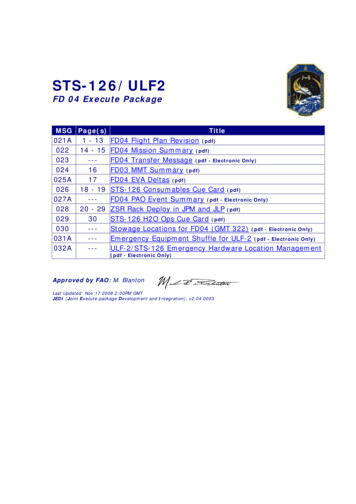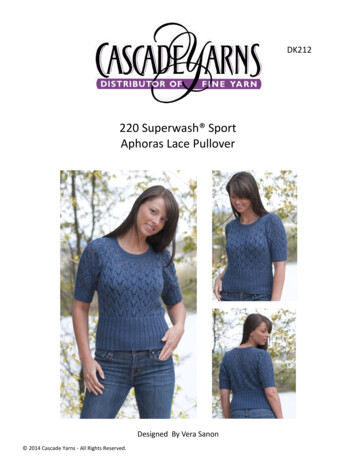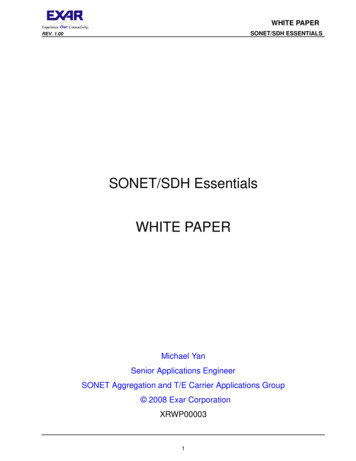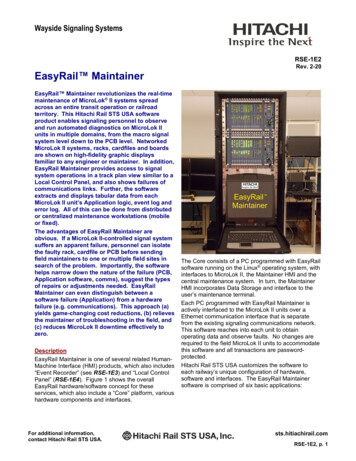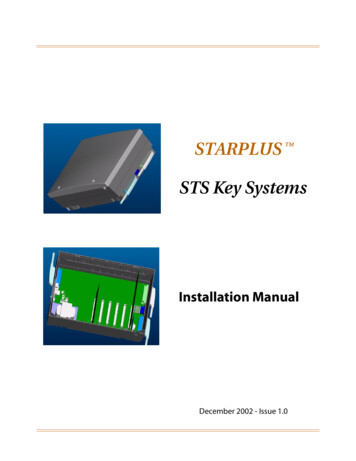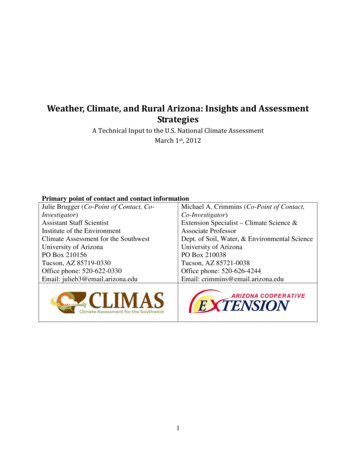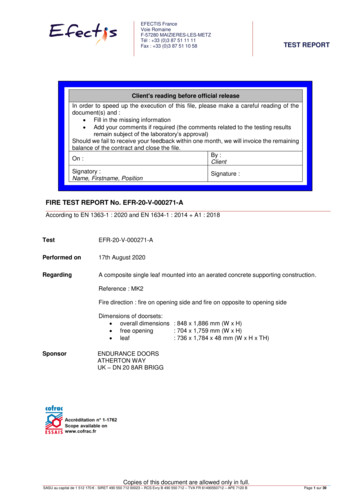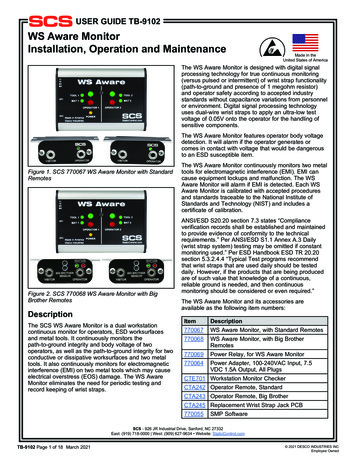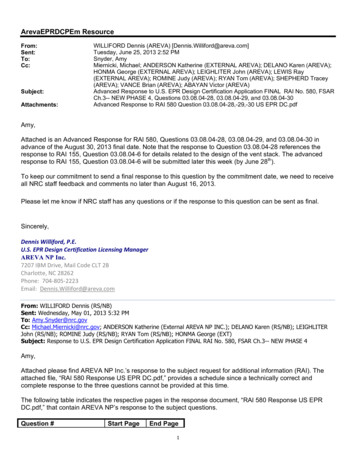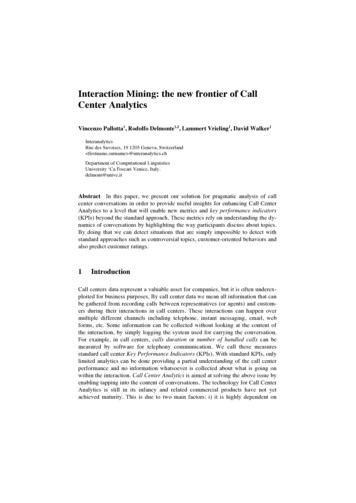
Transcription
STS: Design of Weather-Aware MobileRecommender Systems in TourismMatthias Braunhofer, Mehdi Elahi, Mouzhi Ge, Francesco Ricci, and ThomasSchieveninFree University of Bozen-Bolzano,Piazza Domenicani 3, 39100 Bolzano, . Context-aware recommender systems (RSs) have been mostlyevaluated offline, and very few studies have tried to assess their benefit from the user perspective. Moreover, little research was previouslydedicated to integrate the weather context into RSs that could benefitfrom that information, such as tourism applications. This paper presentsa novel context-aware mobile recommender system, named STS, thatleverages weather context for providing more relevant recommendations.We have evaluated STS in a live user study and have shown that our approach increases choice satisfaction and perceived recommendation quality.1IntroductionRecommender systems help users find interesting products or services [11], andreduce information overload by providing personalized suggestions. The userinterface is a major component of a RS, as it is witnessed by the growing presenceof this topic in conferences dedicated to intelligent user interfaces, e.g., IUI1 .Moreover, the item selection problems supported by RSs are typical influencedby several factors. For example, purchasing a tourism product or visiting a placeof interest (POI), is the outcome of a complex process that is affected by factors”internal” to the user, such as personal motivations and previous experience, and”external” ones, e.g., advices provided by friends, or the convenience to accessthe selected destination [12].In order to deal with these influencing factors a novel line of research onContext-Aware Recommender Systems (CARS) was initiated. CARS generatemore relevant suggestions by adapting to the specific contextual situation of therecommendation [1]. For example, the user’s location and mood have been usedin CARS, and particularly in mobile applications [11].The most recent research on CARS has focused on model-based techniquesthat integrate contextual information directly into the rating prediction model,i.e., trying to improve the accuracy of the predicted rating of an item in a1International Conference on Intelligent User Interfaces: http://www.iuiconf.org
particular contextual situation. While these model-based approaches have beenlargely evaluated in off-line experiments [2, 7], no evaluation was done in liveuser studies. Furthermore, we note that, in tourism applications, the weathercondition that the user will experience at a POI has not been systematicallyexploited in CARS. The main difficulty in managing this type of contextualdata is that it is not linked to the user status, but depends on the item to berecommended – the POI – and dynamically varies in time.In this paper we try to fill these gaps by presenting a mobile CARS, SouthTyrol Suggests (STS), which recommends POIs in South Tyrol (Italy) by taking into account various contextual factors, including the weather conditions atthe recommended POIs. We have conducted a live user study to evaluate thegoodness of the implemented solution and have shown that it increases choicesatisfaction and perceived recommendation quality.2Related WorkIn this paper we exploit and extend a model-based context-aware rating prediction technique originally introduced in [2] by incorporating new contextualfactors describing the weather conditions. Climate and weather conditions areone of the most relevant contextual factors in tourist decision-making. Severalstudies in tourism domain have shown that weather conditions are a significantfactor in tourists’ satisfaction, activity participation, and even in perceived safetyat touristic place [9]. However, weather conditions have not been adequately exploited in context-aware recommender systems yet.A mobile platform was chosen as a natural option for implementing ourtourist application. In [13] the authors made a comprehensive analysis of the top300 mobile apps included in the travel category of iTunes app store and categorized them according to the unique information services they provide and theirdesign features. Although several apps provide recommendations using techniques such as collaborative filtering with context awareness, none of them isreported as using weather conditions as a contextual factor.3STS Design and ApplicationSTS is a mobile context-aware recommender system mainly used for recommending places of interests (POI) in South Tyrol to tourists and local citizens. STShas been implemented as a rich client always-on architecture, i.e., the client hasbeen kept as thin as possible and it works only in a limited way when offline.The Android client comprises a GUI and a presentation logic component; theentire recommendation logic and data layer reside on the server, which makesuse of web services or data storages provided by the Regional Association ofSouth Tyrol’s Tourism Organizations (LTS2 ), the Municipality of Bolzano3 and23LTS: http://www.lts.itMunicipality of Bolzano: http://www.comune.bolzano.it
Mondometeo4 in order to obtain the graphical/textual descriptions as well asweather information for a total of 27,000 POIs.When used for the first time, STS presents a registration screen where theuser can specify a username, date of birth and gender. Next, the user is asked toanswer the Ten-Item Personality Inventory questionnaire [6] so that the systemcan assess their Big Five personality characteristics: conscientiousness, agreeableness, extroversion, emotional stability and openness (an example of collecting extroversion is shown in Figure 1a). Using the given date of birth, genderand the assessed personality as input, the system, which implements an activelearning component [5], identifies and prompts the user to rate a series of POIswhose ratings are expected to best improve the accuracy of the subsequent recommendations.(a)(b)(c)(d)Fig. 1: User interfaces of the STS applicationAfterwards, the system provides recommendations as illustrated in Figure1b. By default, this window provides the tourist with a list of 20 POIs that areconsidered appropriate for the current user and context. In case one of the itemsis interesting to the user, the user can view its details by clicking on it. In thedetailed view, as shown in Figure 1c, STS provides various information about theitem, such as photo, name, description, category and more importantly explanation of the recommendation based on the most influential contextual condition.For example, the sunny weather can be considered as a good motivation for thevisit. Besides, users can also bookmark them, view the POIs on a map and writereviews for them.Regarding the contextual factors, some contextual conditions are automatically acquired such as the weather conditions at each POI, while other factorssuch as time available or mood can be specified by the user (Figure 1d). Eachof these contextual factors can be set or unset by the user, causing them to4Mondometeo: http://www.mondometeo.org
be considered or ignored when generating recommendations. More informationabout the used contextual factors and their associated contextual conditions areshown in Table 1.Table 1: Contextual factors used in the STS applicationContextual ed contextual conditionsSunny, cloudy, rainy, thunderstorm, clear sky, snowingSpring, summer, autumn, winterPrice for quality, budget traveller, high spenderMorning, afternoon, nightWith friends/colleagues, with children, alone, with girlfriend/boyfriend, with familyMoodHappy, sad, active, lazyWeekdayWorking day, weekendTravel goalBusiness, health care, scenic/landscape, hedonistic/fun, religion,visiting friends, education, activity/sport, social eventTransportA car, a bicycle, public transport, no transportation meansSurrounding Knowledge New to area, returning visitor, citizen of the areaCrowdednessCrowded, not crowded, emptyTime availableHalf day, one day, more than one dayTemperatureBurning, hot, warm, cool, cold, freezingDistanceFar away, near byThe recommendation algorithm of STS computes a rating prediction forall tourist items from the database. In order to generate recommendations inreal-time, STS’ underlying recommendation algorithm follows a model-basedapproach from [2], that is, the learning phase is performed offline every five minutes. After the model is learned, recommendations can be generated in constanttime. More details about our deployed recommendation algorithm can be foundin [3].4Evaluation and DiscussionsIn order to evaluate STS, we conducted a user study with 54 participants, whoseages were between 18-35. Users were randomly assigned to two groups, one used avariant of the system that does use the weather factor (STS) and the other trieda variant (STS-S) that has exactly the same interface but the rating predictionand recommendation model is not using the weather factor. The users were askedto look for attractions or events in South Tyrol. The concrete task procedureis as follows: firstly the participants need to consider the contextual conditionsthat are relevant to them and specify them in the system settings (but they wereinvited not to modify the settings related to the weather factor). They were thenasked to browse the attractions and events sections and check whether they couldfind something interesting for them. Also, they were instructed to browse thesystem recommendations, select one that they believed could fit their preferencesand bookmark it. Finally, users needed to fill out a survey and evaluate thesystem they have experienced, with regard to their perceived recommendationquality and choice satisfaction, whose measurements are adopted from [8].
Additionally we provided a post-study section especially on the weather factor. That means after the users had selected a recommended POI, they hadthe opportunity to double check the weather conditions at the selected POI byaccessing the Mondometeo website. If they considered their initial choices notappropriate anymore after having assessed the weather conditions at the selectedPOI, users were able to eventually change their selected POI and bookmark another one. Based on the user’s evaluation, we have compared STS and STS-S,and derived some indications for designing future context-aware recommendersystems, especially in the tourism domain.We have found that users indeed fill out the personality questionnaire, whichsubsequently leads to a higher number of user ratings acquired by the activelearning component compared to a baseline AL approach that does not exploitthat information [5]. Another result, which is more interesting for this paper,is that including the weather factor increases choice satisfaction. Our analysisindicates that almost 60% of the users who have used STS-S changed theirselection after the assessment of the weather conditions, while only 30% of theSTS users changed their selection (this difference is statistically significant – chisquare test). Moreover, including the weather factor can significantly increasechoice satisfaction (t-test probability p 0.01). In particular we found thatSTS users liked significantly more their selected item (p 0.02) and were moreexcited with it (p 0.03).We also found that using the weather factor in the rating prediction modelcan result in a higher perceived recommendation quality. Users believe that POIssuggested by STS were considerably more relevant than those suggested by STSS (p 0.04), and STS users didn’t like the suggested POIs significantly less thanSTS-S users (p 0.001).Moreover, STS was evaluated by using the SUS (System Usability Scale)questionnaire [4], which was handed out to all experimental subjects. SUS scorefor STS is 78.8 and for STS-S is 77; both of them are significantly above theaverage SUS score of 68.In conclusion, STS scored very well in the perceived recommendation qualityand users’ choice satisfaction. As [10] stated, tourism is certainly a primaryapplication area for mobile apps. Device portability makes it easy for the touriststo access information in the different touristic places and helps them to findrelevant attractions and services, or support them in the exploration of certainarea. Our results confirm that the mobile platform can be effectively used fordesigning and implementing context-aware recommender systems, especially intourism domain.5ConclusionIn this paper, we have presented a novel mobile context-aware recommendersystem named STS, which recommends POIs using a set of contextual factorssuch as the weather conditions at the POIs. We have described the design andimplementation of STS. In order to evaluate the application, we have conducted
a user study by measuring user choice satisfaction and perceived recommendation quality. We have found that STS is of high utility and our results indicatethat including the weather factor in tourism recommender systems can yielda higher choice satisfaction and perceived recommendation quality. We believethat this benefit is not limited to mobile applications and we conjecture thateven in a PC-based application, which could be used before the travel, receivingweather-dependent recommendations would increase the user’s acceptance of therecommendations. In the future we would like to improve the user interface andprocedure for collecting users’ feedback. Secondly, beyond the weather factor, wewill conduct further experiments to better assess which contextual factors moresignificantly affect the RS performance.References1. G. Adomavicius, B. Mobasher, F. Ricci, and A. Tuzhilin. Context-aware recommender systems. AI magazine, 32(3):67–80, 2011.2. L. Baltrunas, B. Ludwig, and F. Ricci. Matrix factorization techniques for contextaware recommendation. In Proceedings of the fifth ACM conference on Recommender systems, pages 301–304. ACM, 2011.3. M. Braunhofer, M. Elahi, F. Ricci, and T. Schievenin. Context-aware points ofinterest suggestion with dynamic weather data management. In 21st Conferenceon Information and Communication Technologies in Tourism (ENTER). Springer,2014.4. J. Brooke. Sus-a quick and dirty usability scale. Usability evaluation in industry,189:194, 1996.5. M. Elahi, M. Braunhofer, F. Ricci, and M. Tkalcic. Personality-based active learning for collaborative filtering recommender systems. In AI*IA 2013: Advances inArtificial Intelligence: XIIIth International Conference of the Italian Associationfor Artificial Intelligence, Turin, Italy. Springer, 2013.6. S. D. Gosling, P. J. Rentfrow, and W. B. Swann Jr. A very brief measure of thebig-five personality domains. Journal of Research in personality, 37(6):504–528,2003.7. A. Karatzoglou, L. Baltrunas, K. Church, and M. Böhmer. Climbing the app wall:Enabling mobile app discovery through context-aware recommendations. In Proceedings of the 21st ACM international conference on Information and knowledgemanagement, pages 2527–2530. ACM, 2012.8. B. P. Knijnenburg, M. C. Willemsen, Z. Gantner, H. Soncu, and C. Newell. Explaining the user experience of recommender systems. User Modeling and User-AdaptedInteraction, 22(4-5):441–504, 2012.9. N. Kozak, M. Uysal, and I. Birkan. An analysis of cities based on tourism supplyand climatic conditions in turkey. Tourism Geographies, 10(1):81–97, 2008.10. F. Ricci. Mobile recommender systems. Information Technology & Tourism,12(3):205–231, 2010.11. F. Ricci, L. Rokach, B. Shapira, and P. B. Kantor. Recommender systems handbook.Springer, 2011.12. J. Swarbrooke and S. Horner. Consumer behaviour in tourism. Routledge, 2007.13. D. Wang and Z. Xiang. The new landscape of travel: A comprehensive analysisof smartphone apps. In Information and Communication Technologies in Tourism2012, pages 308–319. Springer, 2012.
STS-S users (p 0.001). Moreover, STS was evaluated by using the SUS (System Usability Scale) questionnaire [4], which was handed out to all experimental subjects. SUS score for STS is 78.8 and for STS-S is 77; both of them are signi cantly above the average SUS score of 68. In conclusion, STS scored very well in the perceived recommendation .
